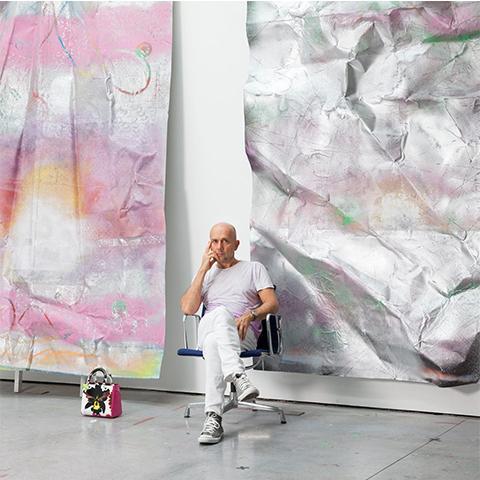On the 15th of July this year, artist Marc Quinn made headlines when he unveiled a new sculpture of Bristol resident and Black Lives Matter protestor, Jen Reid on the plinth where the statue of 17th Century slave trader, Edward Colston was toppled from.

Titled, ‘A Surge of Power’ Quinn says he was inspired by a photo he saw on Instagram of Jen Reid standing on the empty plinth;
"It is such a powerful image, of a moment I felt had to be materialised, forever. The public realm feels so vital at the moment, as a space to activate ideas and create change. It feels essential in particular for public art to play its part. In 2005 I made a sculpture of Alison Lapper Pregnant for Trafalgar Square's Fourth Plinth and learnt how effective public art can be in stimulating attention and discussion around urgent issues. The plinth of Edward Colston in Bristol seems the right place to share this sculpture about the fight against racism, which is undoubtedly the other virus we are fighting today."
Art critic, Alexandra Hall reflects on why ‘A Surge of Power’ is so monumental and artistic rebellion at it’s finest…
“The murder of George Floyd on the 25th of May 2020 electrified the world in an incandescent rage, prompting demonstrations across the world. It feels like the landscape of our world has changed irrevocably, and hopefully for the better. As part of a Black Lives Matter protest in Bristol, the statue of a former slave owner Edward Colton was torn down by protestors. The act of tearing down a historical statue of a slave owner was so significant that it made its way into George Floyd’s eulogy, delivered by Reverend Al Sharpton: ’All over the world I've seen grandchildren of slave masters tearing down slave master statues’. On Wednesday 15th July 2020, a new statue by artist Marc Quinn of protestor Jen Reid was placed where Edward Colston’s monument previously stood. Without any planning permission from the local council, this is artistic rebellion at its finest. It is of a black woman in a black power salute, entitled ‘A Surge of Power’. The statue is designed to be a temporary installation to keep the conversation about racism and colonisation alive. Jen Reid herself said in an interview with The Guardian, “To those who are listening, keep talking, keep righting wrongs when you see them. Keep educating those that want to listen. Unlike Black History Month I hope this statue addresses blackness every day.”

This new wave of monumental revisionism is similar to how countries in Europe responded to decolonisation in the 1970s and 80s. Now we want to see the changes in our culture physically reflected in the world around us. This means that those confederate statues and those monuments to owners of slaves have to go. But how do we go about recognising our colonial past? Is tearing down statues freeing countries from the guilt of their own history?
Statues are historical art that signify a moment of great importance. They indicate that there was a general consensus, an agreement that was reached that concluded that a particular individual was worthy of being immortalised in stone. They become part of our popular conscious, a physical memento that contributes to our understanding of our cultural significance. Like all great art, they are a part of our collective memory that helps us navigate our cultural identity into the future.
What does it say about our countries when we have statues of slave owners erected in our public spaces? Are we recognising the past, or glorifying the mounds of bloodied and sodomised peoples that constitute our past endeavours for ‘empire’? The fact that black students (3.1% of the student population in 2019) who attended Oxford University had to walk past sculptures of famous colonisers on their campuses is abhorrent. Sculptures are placed in public spaces, in the context of our current modernity. Without specific historical context, the fact that they exist in our space constitutes a tacit agreement that they are to be commemorated in our time. It is like if Waterstones still sold children’s books featuring the Golliwog. It is a sign of development that we confront and alter our present in the light of new perspectives, which means facing up to uncomfortable truths about our past.

It is essential that we re-educate ourselves in our history, and that these monuments dedicated to slave owners in the UK are not just pulled down and destroyed. We have a responsibility to hold our present to account for the atrocities of our past, to recognise that it was our people who celebrated violent exploitation. They need to be in our museums, in context, next to important figures who helped to bring about decolonisation. If the statues in our public spaces serve to educate, why is it that we know next to nothing about them? The nationwide curriculum in schools across the UK have no qualms enlightening us about the brutal race rallies of the US in the 1960s, but take no initiative to educate future generations on our own violent past. I asked an old friend of mine, who studied History in Kings College in London, whether even at degree level British colonialism was discussed, and it’s glossed over briefly. We are a people whose ignorance of its own past is designed and structured within our education, these statues of former colonialists in our town squares are not here to rectify that.
Context is essential for history and art. The point of art galleries and museums is to create a space for the art to be art. Separate from the currents of our present reality, it can convey the previously unimaginable, and have distance to reflect reality itself. It is important that the art doesn’t have any other purpose besides to be studied and viewed, it isn’t being used. The problem with public statues is that history and therefore memory can be manipulated and put to different political uses. Last year former Prime Minister Theresa May announced plans for a monument in Waterloo station to commemorate the arrival of the first member of the Windrush generation in 1948 and it was rightly met with hostility. The government did not consult any member of the Caribbean community, or any of the key groups that have been fighting on their behalf. To this date, only 35 people of the Windrush scandal have been granted “urgent and exceptional support” payments, totalling £46,795. In this instance, a statue was being used as a performative symbol to indicate to the public that a government cares about a cause, without any follow-through in policy. It is easy to imagine how often this must have occurred throughout history and why statues might not convey the sincere truth about our past, but a commissioned version of it.
Confronting and revising our past here in the UK will not be an easy and comfortable process. But it does provide the opportunity to see progressive changes to our cultural landscape. As statues and monuments are criticised and pulled down, there is a new blank space to occupy in our towns and cities. Marc Quinn has demonstrated how powerful taking the initiative and honouring a hero of our present-day can be. Art isn’t just activism, it’s history, memory and identity. It’s essential that the conversations about systemic racism do not die down after the protests following George Floyd’s death. We have to examine our culture and tear down structures that have been oppressing minorities, and rebuild them to prioritise equality. It will not end with our statues, it will spread through our education system our entertainment industries and our politics. We’re creating our history every day, and art has the power to help us do that.”
About Marc Quinn
A member of the YBA’s, Marc Quinn is known for his contentious artworks, from casting his head from pints of his own blood, to statues depicting modern icons from Kate Moss to Alison Lapper who he famously placed on the Fourth Plinth in Trafalgar Square.

Quinn’s sculptural work has been captured in dazzling silver glaze in these silksceen ‘Sphinx’ prints depicting Quinn’s iconic, 1996 sculpture of Kate Moss. Contorted into a superhuman form, the original sculpture was part of a series which depicts Moss in an extreme yoga pose.
Quinn captures the idealised unreality of Moss’s beauty, reflecting on the distorting effects of global mass media and the modelling industry. Turning moss into a marble abstraction, Sphinx is a powerful work of contemporary art from one of the leading voices in British art today.






